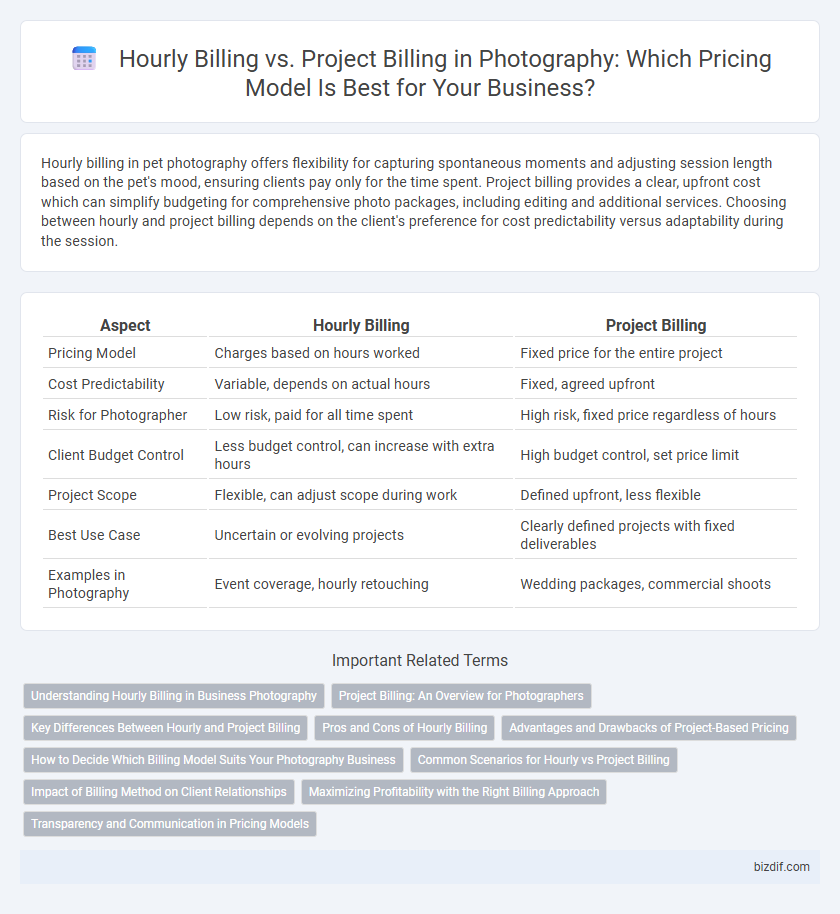Hourly billing in pet photography offers flexibility for capturing spontaneous moments and adjusting session length based on the pet's mood, ensuring clients pay only for the time spent. Project billing provides a clear, upfront cost which can simplify budgeting for comprehensive photo packages, including editing and additional services. Choosing between hourly and project billing depends on the client's preference for cost predictability versus adaptability during the session.
Table of Comparison
| Aspect | Hourly Billing | Project Billing |
|---|---|---|
| Pricing Model | Charges based on hours worked | Fixed price for the entire project |
| Cost Predictability | Variable, depends on actual hours | Fixed, agreed upfront |
| Risk for Photographer | Low risk, paid for all time spent | High risk, fixed price regardless of hours |
| Client Budget Control | Less budget control, can increase with extra hours | High budget control, set price limit |
| Project Scope | Flexible, can adjust scope during work | Defined upfront, less flexible |
| Best Use Case | Uncertain or evolving projects | Clearly defined projects with fixed deliverables |
| Examples in Photography | Event coverage, hourly retouching | Wedding packages, commercial shoots |
Understanding Hourly Billing in Business Photography
Hourly billing in business photography offers precise compensation based on the actual time spent on shoots, editing, and client consultations. This method enables photographers to account for variable factors like location changes and additional setup time, ensuring fair payment for effort. Tracking hours with detailed logs supports transparent invoicing and helps clients understand the value of professional services provided.
Project Billing: An Overview for Photographers
Project billing allows photographers to set a fixed price for the entire shoot, covering all services from pre-production to post-processing. This method offers clear budget expectations for clients and streamlines income management by minimizing unpredictable hourly fluctuations. Photographers can focus on creative quality and timely delivery without tracking each minute spent, improving client satisfaction and project efficiency.
Key Differences Between Hourly and Project Billing
Hourly billing charges clients based on the time spent capturing and editing photos, providing flexibility for variable project scopes but potential unpredictability in final costs. Project billing sets a fixed price for the entire photography assignment, offering clients budget certainty while requiring precise scope definition to avoid scope creep and additional fees. Photographers often choose hourly billing for events or unpredictable shoot durations, whereas project billing suits commercial or product photography with well-defined deliverables.
Pros and Cons of Hourly Billing
Hourly billing in photography offers flexibility by charging clients based on actual time spent, which ensures fair compensation for unpredictable or complex shoots. This method allows photographers to adjust rates for overtime or revisions, but it may cause client uncertainty and require meticulous time tracking. Potential downsides include client hesitancy due to fluctuating costs and the challenge of justifying hours worked without visible deliverables.
Advantages and Drawbacks of Project-Based Pricing
Project-based pricing offers photographers clear financial expectations and encourages efficient workflow by setting fixed fees for entire assignments, which clients often prefer for budgeting purposes. This method can lead to higher profitability if the scope is well-defined, but it carries the risk of undercharging if project complexities or time spent exceed initial estimates. Conversely, lack of flexibility in accommodating scope changes may cause disputes or reduced client satisfaction, making precise contract terms essential.
How to Decide Which Billing Model Suits Your Photography Business
Choosing between hourly billing and project billing for a photography business depends on factors like client preferences, project scope, and complexity. Hourly billing suits unpredictable or varying workloads, ensuring fair compensation for time spent, while project billing works best for clearly defined tasks with fixed deliverables. Assess typical job duration, client expectations, and your workflow to determine the most profitable and efficient model for your photography services.
Common Scenarios for Hourly vs Project Billing
Hourly billing suits photography projects with uncertain scope or variable client demands, such as event coverage or extended photo sessions where time investment fluctuates. Project billing fits well for clearly defined assignments like product shoots or pre-planned portrait sessions with fixed deliverables and timelines. Photographers often choose hourly rates for flexibility and project fees to ensure predictable income and straightforward budgeting.
Impact of Billing Method on Client Relationships
Hourly billing can create transparency and flexibility by allowing clients to pay based on actual time spent, fostering trust through detailed invoicing. Project billing offers clients a clear budget upfront, reducing financial uncertainty and often enhancing satisfaction by setting defined expectations. Choosing the right billing method significantly influences client relationships by balancing clarity, trust, and satisfaction throughout the photography service process.
Maximizing Profitability with the Right Billing Approach
Photographers maximize profitability by choosing between hourly billing, which ensures compensation for time spent, and project billing, which leverages clear deliverables to attract clients seeking transparent pricing. Understanding client expectations and project scope helps determine the optimal approach to avoid undercharging or overextending resources. Implementing hybrid strategies, such as hourly rates for revisions within a fixed project fee, can further enhance revenue while maintaining client satisfaction.
Transparency and Communication in Pricing Models
Hourly billing in photography offers transparency by allowing clients to see the exact time invested in each task, fostering clear communication regarding scope changes and additional requests. Project billing provides a fixed price, simplifying budgeting but requiring detailed upfront discussions to ensure all deliverables and potential extra costs are understood. Transparent pricing models enhance trust and client satisfaction, making communication essential to align expectations and avoid disputes.
Hourly Billing vs Project Billing Infographic

 bizdif.com
bizdif.com